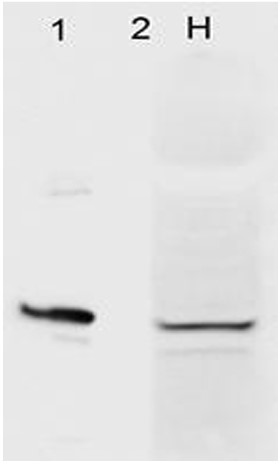Anti-Aha1 Antibody (11140)
$346.00
SKU: 11140
Categories: Antibody Products, Heat Shock and Stress Protein Antibodies, New Products, Products
Overview
Product Name Anti-Aha1 Antibody (11140)
Description Anti-Aha1 Mouse Monoclonal Antibody
Target Aha1
Species Reactivity Human, Mouse
Applications WB,ELISA
Host Mouse
Clonality Monoclonal
Clone ID 4H9-D7
Isotype IgG1
Immunogen His-tagged recombinant human Aha1 (accession no. NP_036243.1)
Properties
Form Liquid
Concentration 1.0 mg/mL
Formulation PBS, pH 7.4, 50% glycerol, 0.09% sodium azide.Purified by Protein G affinity chromatography.
Buffer Formulation Phosphate Buffered Saline
Buffer pH pH 7.4
Buffer Anti-Microbial 0.09% Sodium Azide
Buffer Cryopreservative 50% Glycerol
Format Purified
Purification Purified by Protein G affinity chromatography
Specificity Information
Specificity This antibody recognizes human and mouse Aha1 and cross-reacts with mouse Aha2.
Target Name Activator of 90 kDa heat shock protein ATPase homolog 1
Target ID Aha1
Uniprot ID O95433
Alternative Names AHA1, p38
Gene Name AHSA1
Gene ID 10598
Accession Number NP_036243.1
Sequence Location Cytoplasm, cytosol, Endoplasmic reticulum
Biological Function Acts as a co-chaperone of HSP90AA1 (PubMed:29127155). Activates the ATPase activity of HSP90AA1 leading to increase in its chaperone activity (PubMed:29127155). Competes with the inhibitory co-chaperone FNIP1 for binding to HSP90AA1, thereby providing a reciprocal regulatory mechanism for chaperoning of client proteins (PubMed:27353360). Competes with the inhibitory co-chaperone TSC1 for binding to HSP90AA1, thereby providing a reciprocal regulatory mechanism for chaperoning of client proteins (PubMed:29127155). {PubMed:27353360, PubMed:29127155}.
Research Areas Heat Shock& Stress Proteins
Background Aha1 is a member of the Hsp90 co- chaperone family that appears to stimulate Hsp90 ATPase activity by competing with p23 and other co- chaperones for Hsp90 binding. Aha1 also interacts with HSPCA/Hsp90 and with the cytoplasmic tail of the vesicular stomatitis virus glycoproteins (VSV-G). Aha 1 is expressed in numerous tissues including brain, heart, skeletal muscle, and kidney and is present at low levels in liver and placenta.
Application Images


Description Immunoblotting: use at 1ug/ml. A band of ~38kDa is detected. Band can appear as high as 45kDa. Western blot detection of Aha1 in (1) HeLa cells and recombinant Aha1 (H) with #11140 at 1ug/ml.
Handling
Storage This antibody is stable for at least one (1) year at -20°C.
Dilution Instructions Dilute in PBS or medium which is identical to that used in the assay system.
Application Instructions Immunoblotting: use at 1ug/mL. A band of ~38kDa is detected. Band can appear as high as 45kDa
ELISA: use at 1-10ug/mL with Aha1 on the solid phase.
These are recommended concentrations;
Enduser should determine optimal concentrations for their applications.
ELISA: use at 1-10ug/mL with Aha1 on the solid phase.
These are recommended concentrations;
Enduser should determine optimal concentrations for their applications.
References & Data Sheet
Data Sheet  Download PDF Data Sheet
Download PDF Data Sheet
 Download PDF Data Sheet
Download PDF Data Sheet


